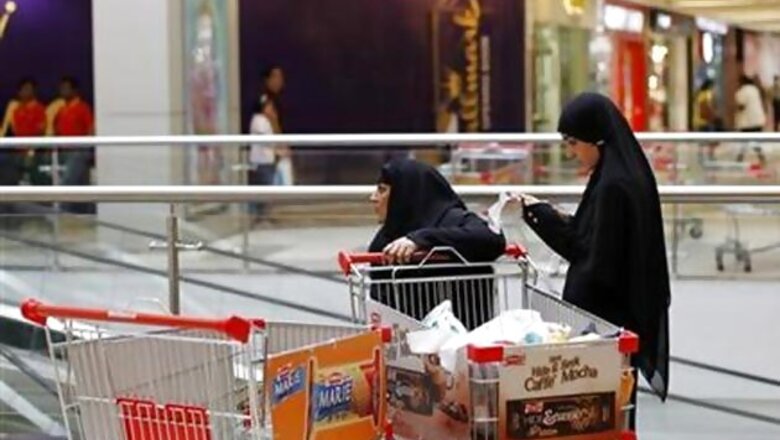
views
Mumbai: The biggest shopping mall in Mumbai, one of the world's most crowded cities, can feel like a pretty lonely place. Eight months ago, multi-storied Phoenix Market City opened for business in the eastern suburb of Kurla with a total floor area of 1.13 million square feet, the size of about 15 soccer fields. Till now, just two-thirds of its 320 stores have been taken up and foot traffic can be thin.
Asia's third-largest economy is growing at its slowest pace in nine years and sluggish consumer spending is forcing mall developers to scale back plans. It will take years for the glut of retail space conceived during headier times to be absorbed by tenants, even as India fine-tunes rules to make it easier for foreign shops to enter the country on their own, analysts say.
"We are holding back on new store openings and focusing on our existing stores," said Ramesh Tainwala, chairman of Planet Retail, which has leased shops in Phoenix Market City and is the Indian partner of global retail brands, including Body Shop, Next, Nautica and Debenhams.
"We are shutting down some of our stores in areas where rentals are too high, and with the slowdown in consumption complicating things further," he said, adding that the company is also asking landlords to renegotiate rents.
Consumer spending is on track to grow just 5.7 per cent this year, compared with 24 per cent in 2010, according to Euromonitor International, a feeble pace for a domestic demand-led economy.
Nationally, retail vacancy rates are 20 per cent and will likely rise to 25 per cent by 2014, according to property consultants Jones Lang LaSalle, as floor space in malls grows to 100 million square feet from 66 million now. More than 90 per cent of shopping in India is still done at unorganised one-off shops.
By comparison, Thailand's capital of Bangkok alone has 62 million square feet of mall space, of which only about 7 per cent is empty, according to a report by CB Richard Ellis.
"There are just not enough people walking in," said Akshay Khatri, who manages the Van Heusen apparel store in Phoenix Market City, which is developed by Phoenix Mills, one of India's few developers specialising in malls.
Vacant malls, though, are also to be found in China where there has been a rush to build them. The 7 million-square-foot New South China Mall in the southern manufacturing city of Dongguan - the biggest mall in the world - is mostly vacant.
EMPTY SHOPS
Of the 12 million square feet of Indian shopping centre space planned for opening in 2012, only about 60 per cent is expected to do so, according to Jones Lang LaSalle, as delayed mall projects dot India's biggest cities.
DLF, India's largest property developer, has kept its proposed 4.5 million square foot Mall of India project in Gurgaon on hold since late 2008. That mall was to have been India's largest, with 2 million square feet of retail space.
"The crazy building boom in retail real estate is not going to come back," said Kishore Bhatija, chief executive officer of InOrbit Malls, owned by developer K Raheja, which altered its plan for a 500,000 square-foot-mall in Vadodara to 400,000 square feet, and added a hotel instead.
"There is stress on the business model. It is getting a bit expensive. Real estate prices and construction costs are rising but the retail business is not growing enough to absorb this," said Bhatija, adding that breakeven on projects is lengthening, in some cases to 10 or more years from seven in 2007-2008.
In fast-growing cities like Ahmedabad, Pune and the New Delhi region, vacancy rates at malls are more than 25 per cent, according to property consultants Cushman & Wakefield, putting pressure on rents.
Retail rents are down 30-40 per cent from peaks in 2008, according to ratings agency Crisil. That's especially painful for developers, when servicing loans is expensive at 12-13 per cent interest. The building boom of 2007-2008 was funded in part by cheap private equity.
Shubhranshu Pani, managing director of retail at Jones Lang LaSalle, said when the downturn in 2008/09 spurred a correction in rents there was a shift from fixed rents to revenue-linked rents, putting more risk on the developer.
"Just increasing rents will not work because at the end of the day it has to be affordable for retailers to do business," said InOrbit's Bhatija.
SLOW START
India recently allowed full foreign ownership in single brand retail, but retailers have not rushed in to set up shop on their own as sourcing rules remain a challenge. Only Sweden's Ikea, the world's biggest furniture retailer, and UK shoe chain Pavers have applied to enter under the new rules.
India may also soon revive a plan to allow in foreign supermarkets such as Wal-Mart Stores and Carrefour, which could eventually create huge anchor tenants for shopping centres.
"Will that mean an immediate expansion of shopping centres? No," said Sanjay Dutt, managing director at Cushman & Wakefield. "It will take three, four years until there is a big revival," he said.
At Phoenix Market City in Mumbai only 205 of the 255 leased stores are open.
"We have quite a lot of stores there and the current traffic is rather disappointing," said Planet Retail's Tainwala.
Reflecting some of the concerns, shares of Phoenix Mills, which has four malls across India, are down about 15.3 per cent over the past year, underperforming the wider Mumbai market .BSESN which is down about 10.7 per cent.
Shishir Srivastava, CEO of Phoenix Mills, believes that once a multiplex cinema and bowling alley open in coming months and more retailers like Lancome, Esprit, and Inditex's Zara open shop, traffic will increase and monthly sales will rise from the current 770 rupees a square foot.
Monthly spending at its original mall, the popular High Street Phoenix in central Mumbai, India's largest city, is 1,500-1,600 rupees a square foot.

















Comments
0 comment